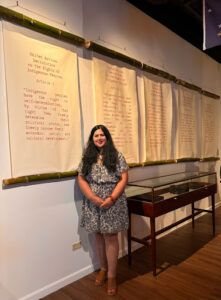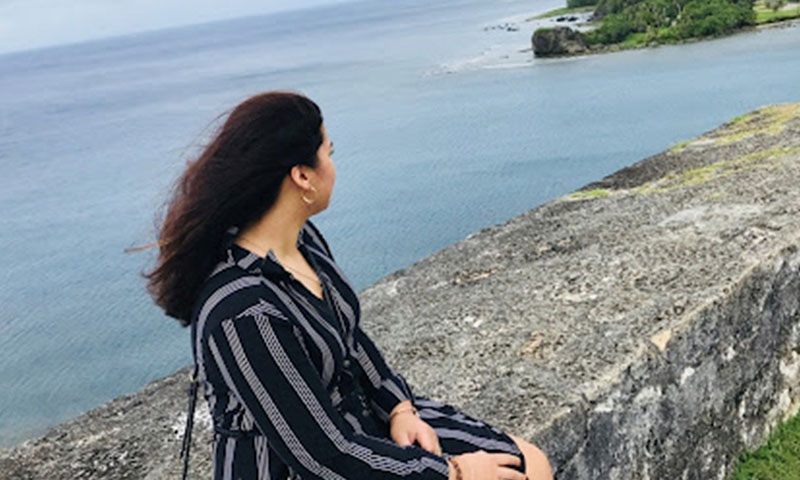A Chamorro Daughter’s Journey Back to Guam By Dr. Mary Kate Soliva
Life’s journey often begins in the place we call “home.” Yet for many of us who have served in the military, it can take years before we return there for any meaningful length of time. Guam has always been a core part of my identity, as my family’s bloodline stretches back for generations, but for much of my life, I called Maryland home, with military service frequently changing my address. My grandmother likes to say she keeps my mailing address written in pencil, ready to erase and update it with each new move.
Through all those transitions, I carried with me a longing to know my heritage more deeply. Still, I often felt a sense of distance from the traditions and daily customs shaping life on the island. When I boarded the plane from Maryland to Guam just a month ago, I knew I was heading toward something both deeply familiar and completely new. I still consider myself a student of culture and family history. I recall a wholesome memory of helping set up the fiesta table and making the dreaded mistake of setting the rice at the very end. My great-aunt could be heard across the lawn, “Who put the rice at the end of the table?!”, and my cousins quickly pointed at me. I was quickly referred to as a “coconut”, white on the inside, though brown on the outside. A simple example of the duality I feel as someone with indigenous Chamorro blood but raised in the U.S mainland.
It’s often said you can see the history of Guam through the food on the fiesta table, with Chamorro food at the start of the table and American, Japanese, and other cuisines following. There is a complex and rich history here, and I have a deep respect for the community and people who call Guam “home”. Identity is not inherited, and in my opinion, must be lived and felt. To my surprise, many people thank me for returning to Guam, especially since so many from my generation have left for the U.S. mainland in search of better opportunities and an easier life. It is what we call being “priced out of paradise”.
The Value of Inafa’maolek
One of the most important values I have encountered in Guam is inafa’maolek, which has one possible translation: to “make things good for each other.” It is the idea of selflessly promoting harmony, reciprocity, and care for the community. I’ve witnessed this practice every day with moments of people sharing food, helping the elderly, volunteering at village events, and welcoming someone new, like me, with generosity.
For me, inafa’maolek has become both a guide and a reminder. It guides me in how I approach community life: not with a checklist of what I know or don’t know, but with a spirit of giving and learning. It’s a powerful reminder of how preparedness, whether for daily life or for emergencies, is not an individual act but a collective one. As the saying goes, “it takes a village”.
Lessons for Families
For parents and families, my journey holds lessons extending beyond Guam. Many of us move across oceans or neighborhoods and navigate environments where we feel both like insiders and outsiders. For children especially, these transitions ignite questions about identity and belonging.
Here are a few lessons I’ve learned to help families embrace such transitions:
1. Cherish what you bring.
Even if you feel like a newcomer, you carry values, traditions, and meaningful experiences. For me, the discipline and resilience I gained from years of work in the mainland enrich the way I contribute to life in Guam. Families can help children see their own experiences as strengths rather than shortcomings.
2. Practice humility as a strength.
It is okay not to know everything. Had I dared to ask where the rice went, I would’ve avoided my great-aunt’s wrath and such a humbling moment. When families model curiosity and the willingness to ask questions, they show children how learning is a lifelong process, not a weakness.
3. Stay grounded in the community.
Belonging is built through relationships. It is easy to take for granted the people who make up a community. However, real change and community come from taking part in local events, volunteering, or simply sharing meals, which help weave connections. Families can use community ties as a source of stability and strength during times of change.
4. Teach resilience through culture.
Culture is more than history; it is a living resource for resilience, ever evolving and still woven into the fabric of our being. For Chamorros, values like inafa’maolek remind us how collective care makes us stronger. For other families, reconnecting with cultural traditions can provide children with a sense of belonging and rootedness, regardless of where they live.
5. Embrace growth together.
Transitions are not just for children; they are also opportunities for adults to grow and develop. Sharing stories of your own challenges and learning moments can help children see how everyone, regardless of age, is still on a journey of becoming. My grandfather often said, “No one can take your education away from you, so never stop learning.”
Lifelong Learning
My return to Guam has shown me how homecoming is not a destination but a process I’m excited to share with my family. It is about honoring where we come from while acknowledging how identity is continuously shaped by how we live, learn, and give back. For parents, this is an empowering message: our children do not need to “arrive” at a fixed sense of identity. Instead, they can embrace the richness of becoming, balancing pride in who they are with humility, which drives them to continue learning. As I continue to settle into life on Guam, I carry with me both the bloodline connecting me to this land and the humility of a lifelong student. I have found a deeper kind of preparedness for life itself. In Guam, these values are clear: care for one another and embrace your heritage, regardless of your address. As I continue my journey in Guam, I hope to live with the values of inafa’maolek more fully each day. ❦
 About the Author
About the Author
Dr. Mary Kate Soliva is a Special Operations Army Veteran and co-founder of the Guam Human Rights Initiative (GHRI), where she leads efforts to advance human rights in Guam and the Pacific through research and advocacy. Under her leadership, GHRI presented at the United Nations Minority Assembly in Geneva, Switzerland. Soliva is a Hoover Institution Veteran Fellow in the inaugural fellowship program under the direction of former U.S. Secretary of State Dr. Condoleezza Rice.
She is an Assistant Professor of Public Administration and Criminal Justice at the University of Guam. A TEDx Hagåtña speaker, Soliva continues to demonstrate how homeland security and human rights are deeply interconnected, inspiring the next generation of changemakers. Most importantly, she loves to travel and live life with her husband, Nelson.
